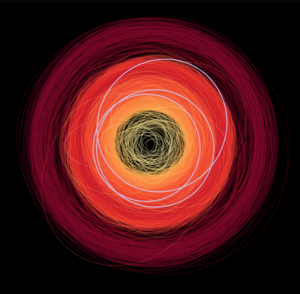

Gaia Asteroid detections
As it scans the sky surveying stars in the Milky Way galaxy, Gaia has also detected a wealth of asteroids, the small rocky bodies that populate our solar system, mainly between the orbits of Mars and Jupiter. Because they are relatively nearby and orbiting the Sun, asteroids appear to move against the stars in astronomical images, appearing in one snapshot of a given field, but not in images of the same field taken at other times.
Gaia scientists have developed special software to look for these 'outliers', matching them with the orbits of known asteroids in order to remove them from the data being used to study stars. But in turn, this information will be used to characterise known asteroids and to discover thousands of new ones.
This image shows Gaia's detections of asteroids in eight months' worth of data, compared with the positions on the sky of a sample of 50 000 known asteroids. The colour of the data points is an indication of the accuracy of the detections, showing the separation on the sky between the observed position of Gaia's detection and the expected position of each asteroid: blue indicates higher accuracy, whereas green and red indicate lower accuracy.
The regions showing lower accuracy of asteroid detections correspond to patches of the sky where the stellar density is very high, thus complicating the identification process.





